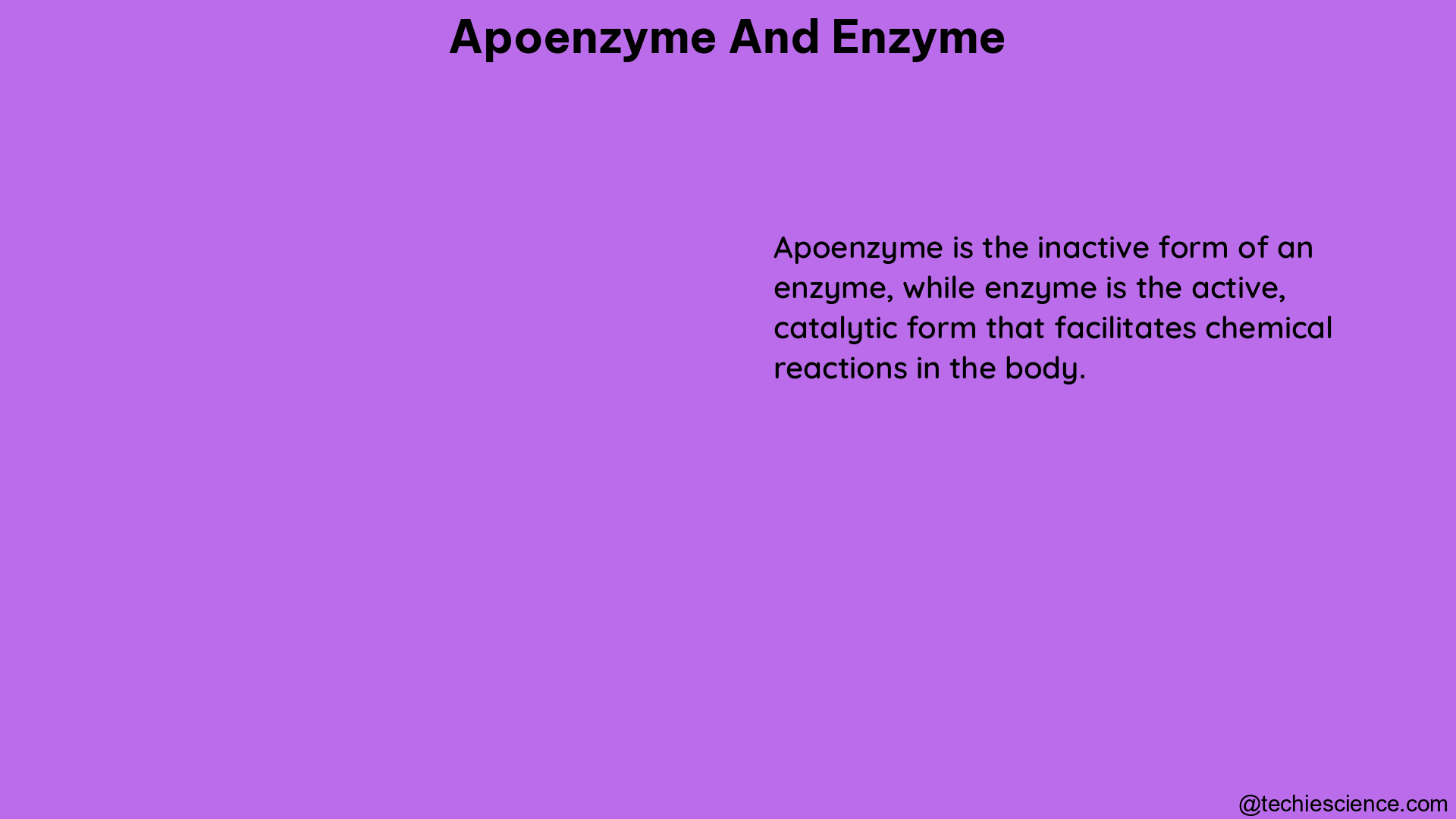Apoenzymes and enzymes are fundamental components in the intricate world of biochemistry, playing crucial roles in catalyzing and regulating the myriad of chemical reactions that sustain life. Understanding the intricacies of these biomolecules is essential for any aspiring biologist or biochemist. This comprehensive guide will delve into the measurable and quantifiable data, as well as the theoretical frameworks, that underpin the study of apoenzymes and enzymes.
Understanding Apoenzymes and Enzymes
Apoenzymes are protein molecules that, when combined with a specific cofactor, form an active enzyme, known as a holoenzyme. These cofactors can be either metal ions or organic molecules called coenzymes. Enzymes, on the other hand, are biological catalysts that accelerate the rates of chemical reactions within living organisms, often by several orders of magnitude.
Measuring and Quantifying Apoenzyme and Enzyme Properties

Enzyme Activity
Enzyme activity is a crucial parameter that reflects the catalytic efficiency of an enzyme. It is measured in units called “international units” (IU), where one unit is defined as the amount of enzyme that catalyzes the conversion of one micromole of substrate per minute under specified conditions. This measurement provides valuable insights into the potency and effectiveness of an enzyme in a given reaction.
Protein Concentration
The concentration of apoenzymes or enzymes can be determined using various analytical techniques, such as the Bradford assay, Lowry assay, or BCA assay. These methods rely on the principle that proteins bind to specific reagents, resulting in a color change that is proportional to the protein concentration. Accurate quantification of protein levels is essential for understanding enzyme kinetics and stoichiometry.
Kinetic Parameters
Enzyme kinetics involves the measurement of the rate of enzyme-catalyzed reactions under different conditions. Key parameters include the Michaelis-Menten constant (Km), the maximum reaction velocity (Vmax), and the turnover number (kcat). The Km reflects the substrate concentration at which the enzyme operates at half its maximum velocity, while Vmax represents the maximum rate of the reaction. The turnover number, on the other hand, indicates the number of substrate molecules converted to product per active site per second, providing a measure of the catalytic efficiency of the enzyme.
Thermodynamic Parameters
The activation energy (Ea) and the change in free energy (ΔG) of enzyme-catalyzed reactions can be measured using calorimetric or spectroscopic techniques. These parameters provide insights into the energetics of the reaction, including the energy barrier that must be overcome for the reaction to occur and the overall thermodynamic favorability of the process.
Structural Data
Advanced analytical techniques, such as X-ray crystallography and nuclear magnetic resonance (NMR) spectroscopy, can be employed to determine the three-dimensional structure of apoenzymes and enzymes. This structural information is invaluable for understanding the mechanism of action, substrate specificity, and regulatory mechanisms of these biomolecules.
Theoretical Frameworks and Equations
Michaelis-Menten Equation
The Michaelis-Menten equation is a fundamental relationship that describes the relationship between the initial velocity (V) of an enzyme-catalyzed reaction, the substrate concentration ([S]), the Michaelis-Menten constant (Km), and the maximum reaction velocity (Vmax). This equation is expressed as:
V = (Vmax × [S]) / (Km + [S])
This equation allows for the determination of kinetic parameters and the prediction of enzyme behavior under different substrate concentrations.
Lineweaver-Burk Plot
The Lineweaver-Burk plot is a graphical representation of the Michaelis-Menten equation, which allows for the determination of kinetic parameters such as Km and Vmax from experimental data. This plot is constructed by plotting the reciprocal of the initial velocity (1/V) against the reciprocal of the substrate concentration (1/[S]). The resulting linear plot can be used to extract the values of Km and Vmax from the x-intercept and y-intercept, respectively.
Eadie-Hofstee Plot
The Eadie-Hofstee plot is an alternative graphical representation of enzyme kinetics that provides another method for determining kinetic parameters. In this plot, the initial velocity (V) is plotted against the ratio of the initial velocity to the substrate concentration (V/[S]). The resulting linear plot can be used to determine the Km and Vmax values from the slope and y-intercept, respectively.
Arrhenius Equation
The Arrhenius equation describes the relationship between the rate constant (k) of a reaction, the activation energy (Ea), and the absolute temperature (T). The equation is expressed as:
k = A × e^(-Ea/RT)
where A is the pre-exponential factor, R is the universal gas constant, and T is the absolute temperature. This equation allows for the determination of the activation energy and the temperature dependence of enzyme-catalyzed reactions.
Conclusion
Apoenzymes and enzymes are fundamental to the understanding of biochemical processes in living organisms. By mastering the measurement and quantification of their properties, as well as the theoretical frameworks that govern their behavior, biologists and biochemists can gain a deeper appreciation for the intricate mechanisms that sustain life. This comprehensive guide has provided a solid foundation for exploring the world of apoenzymes and enzymes, equipping you with the knowledge and tools necessary to excel in your studies and research.
References:
- Bisswanger, H. (2008). Enzyme Kinetics: Principles and Methods. 2nd edn. Weinheim, Germany: Wiley-VCH.
- Buchholz, K., Kasche, V., & Bornscheuer, U.T. (2012). Biocatalysts and Enzyme Technology. 2nd edn. Weinheim, Germany: Wiley-VCH.
- Copeland, R.A. (2013). Evaluation of Enzyme Inhibitors in Drug Discovery: A Guide for Medicinal Chemists and Pharmacologists. 2nd edn. Hoboken NJ., editor. John Wiley & Sons, Inc.
- Quizlet. (n.d.). Week 1 Enzymology. Retrieved from https://quizlet.com/621158306/week-1-enzymology-flash-cards/
- ScienceDirect. (n.d.). Apoenzyme. Retrieved from https://www.sciencedirect.com/topics/pharmacology-toxicology-and-pharmaceutical-science/apoenzyme
- NCBI. (2015). Enzyme Kinetics: Rapid-Equilibrium Rate-Velocity Relationships. Retrieved from https://www.ncbi.nlm.nih.gov/pmc/articles/PMC4692135/

Hello, I am Piyali Das, pursuing my Post Graduation in Zoology from Calcutta University. I am very passionate on Academic Article writing. My aim is to explain complex things in simple way through my writings for the readers.